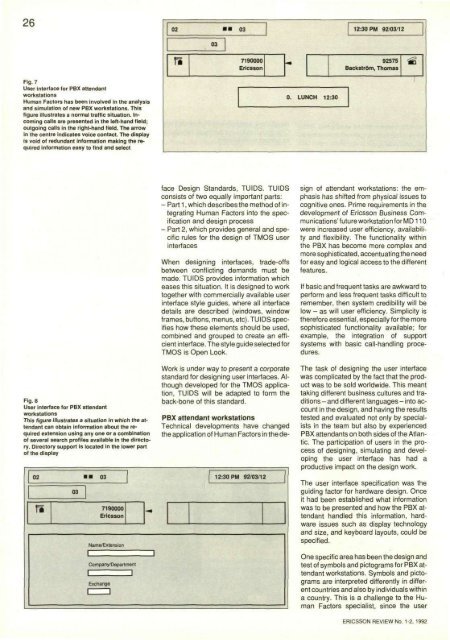Frame Relay - for Faster and More Efficient Data Communications ...
Frame Relay - for Faster and More Efficient Data Communications ...
Frame Relay - for Faster and More Efficient Data Communications ...
- No tags were found...
Create successful ePaper yourself
Turn your PDF publications into a flip-book with our unique Google optimized e-Paper software.
Fig. 7User interface <strong>for</strong> PBX attendantworkstationsHuman Factors has been involved in the analysis<strong>and</strong> simulation of new PBX workstations. Thisfigure illustrates a normal traffic situation. Incomingcalls are presented in the left-h<strong>and</strong> field;outgoing calls in the right-h<strong>and</strong> field. The arrowin the centre indicates voice contact. The displayis void of redundant in<strong>for</strong>mation making the requiredin<strong>for</strong>mation easy to find <strong>and</strong> selectFig. 8User interface <strong>for</strong> PBX attendantworkstationsThis figure illustrates a situation in which the attendantcan obtain in<strong>for</strong>mation about the requiredextension using any one or a combinationof several search profiles available in the directory.Directory support is located in the lower partof the displayface Design St<strong>and</strong>ards, TUIDS. TUIDSconsists of two equally important parts:- Part 1, which describes the method of integratingHuman Factors into the specification<strong>and</strong> design process- Part 2, which provides general <strong>and</strong> specificrules <strong>for</strong> the design of TMOS userinterfacesWhen designing interfaces, trade-offsbetween conflicting dem<strong>and</strong>s must bemade. TUIDS provides in<strong>for</strong>mation whicheases this situation. It is designed to worktogether with commercially available userinterface style guides, where all interfacedetails are described (windows, windowframes, buttons, menus, etc). TUIDS specifieshow these elements should be used,combined <strong>and</strong> grouped to create an efficientinterface. The style guide selected <strong>for</strong>TMOS is Open Look.Work is under way to present a corporatest<strong>and</strong>ard <strong>for</strong> designing user interfaces. Althoughdeveloped <strong>for</strong> the TMOS application,TUIDS will be adapted to <strong>for</strong>m theback-bone of this st<strong>and</strong>ard.PBX attendant workstationsTechnical developments have changedthe application of Human Factors in thede-sign of attendant workstations: the emphasishas shifted from physical issues tocognitive ones. Prime requirements in thedevelopment of Ericsson Business <strong>Communications</strong>'futureworkstation<strong>for</strong>MD110were increased user efficiency, availability<strong>and</strong> flexibility. The functionality withinthe PBX has become more complex <strong>and</strong>more sophisticated, accentuating the need<strong>for</strong> easy <strong>and</strong> logical access to the differentfeatures.If basic <strong>and</strong> frequent tasks are awkward toper<strong>for</strong>m <strong>and</strong> less frequent tasks difficult toremember, then system credibility will below - as will user efficiency. Simplicity isthere<strong>for</strong>e essential, especially <strong>for</strong> the moresophisticated functionality available; <strong>for</strong>example, the integration of supportsystems with basic call-h<strong>and</strong>ling procedures.The task of designing the user interfacewas complicated by the fact that the productwas to be sold worldwide. This meanttaking different business cultures <strong>and</strong> traditions- <strong>and</strong> different languages - into accountin the design, <strong>and</strong> having the resultstested <strong>and</strong> evaluated not only by specialistsin the team but also by experiencedPBX attendants on both sides of the Atlantic.The participation of users in the processof designing, simulating <strong>and</strong> developingthe user interface has had aproductive impact on the design work.The user interface specification was theguiding factor <strong>for</strong> hardware design. Onceit had been established what in<strong>for</strong>mationwas to be presented <strong>and</strong> how the PBX attendanth<strong>and</strong>led this in<strong>for</strong>mation, hardwareissues such as display technology<strong>and</strong> size, <strong>and</strong> keyboard layouts, could bespecified.One specific area has been the design <strong>and</strong>test of symbols <strong>and</strong> pictograms <strong>for</strong> PBX attendantworkstations. Symbols <strong>and</strong> pictogramsare interpreted differently in differentcountries <strong>and</strong> also by individuals withina country. This is a challenge to the HumanFactors specialist, since the userERICSSON REVIEW No. 1-2, 1992















